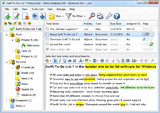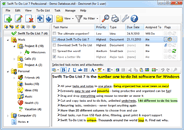As we’ve established in past GTD Basics posts, the adage that “knowing is half the battle” generally rings true wherever productivity is concerned. In order to succeed in Getting Things Done, you can’t just jump right into the tasks at hand (however tempting that might be). Instead, you need to approach tasks more slowly so that you can move quickly once you’re actually working. Preparation is essential, and as David Allen explains in Getting Things Done: The Art of Stress-Free Productivity, a crucial component is managing your actions.
The practices that promote productivity and GTD are somewhat akin to fractals – if you keep looking closer and closer, the same patterns inevitably recur. At a macro level, GTD requires managing your commitments and tasks through organization and clarification. And at a micro level, GTD requires managing the actions, or steps, each task requires.
Horizontal task management is the macro level. Vertical management is the micro level.
Managing actions helps to further the process of converting the overwhelming mass of your commitments into a coherent, organized and, most importantly, workable set of steps you need to take. Managing actions gives you a clear plan of attack, a manageable group of goals and an improved perspective. And, because breaking things down as far as possible helps make things easier, we’re going to divide your actions into two categories: horizontal and vertical.
Horizontal Action Management
Horizontal action management may sound like a complicated fitness move, but it is simply a means by which you can accomplish actions relating to a number of tasks efficiently. You can think of it as your ‘two birds, one stone’ system, because horizontal action management looks at all of the tasks you have and identifies a common action or actions that moves multiple tasks toward completion.
For example, if your tasks include washing your dog and taking a shower, securing towels is an action that will help you move toward completing each task. Instead of getting one towel when you need it, a horizontal action management system would have you get both towels at once so they are ready when you need them.
If horizontal action management sounds difficult, you can use Swift To-Do List to simplify matters. The program allows you to attach notes and documents to tasks on your list, which is perfectly suited to action management. I like to create bulleted lists of actions for each task in the notes area so I know what steps I need to take to complete a given task. To perform horizontal action management, I look at the bulleted list for each task and identify actions common to multiple tasks. Then, I create a sub-list and enter these actions as my priority/efficiency actions – the steps I can take to make progress on multiple assignments at once.
After a while, you may notice that your horizontal action management tends to reveal preparatory actions, like gathering supplies or research. If the same actions recur in an organized manner, you can use Swift To-Do List 7 to send you reminder e-mails on a consistent basis. Often, the common actions are “first steps” in completing tasks, and by managing them all at once, you can have a head start on future projects.
Vertical Action Management
Vertical action management doesn’t have as much of a “big picture” scope as horizontal task management, but it is still important. Vertical action management is, as Allen puts it, “’project planning’…focusing in on a single endeavor, situation, or person and fleshing out whatever ideas, details, priorities and sequences of events may be required for you to handle it.”
You can think of vertical action management as a checklist or a to-do list, which makes Swift To-Do List 7 such an effective tool for this technique. For vertical action management, you need to list all of the steps required for completion of a task. It’s important to be as detailed as possible and list even preparatory actions. Breaking down tasks into as many actions as possible is important because it makes them more manageable and allows you to identify common actions in the horizontal action management process.
Discover more about the benefits of “breaking tasks down” in the very popular post called “10 best tricks of fooling myself to work“.
The smaller the actions, the more likely you will be to knock them out during the time you have between meetings, lunch or major task work. If you don’t break down your tasks, they can be overwhelming and you’ll need to set aside large blocks of time to accomplish anything and you’ll miss out on the consolidation of actions offered by horizontal action management. Additionally, having a list of actions enumerated for each task allows you to assess your progress more often.
Putting It All Together
Both horizontal and vertical action management are effective tools, but they are most effective when used together. Typically, beginning with vertical action management can be helpful, because when you finish you’ll be able to see the common actions you need to consolidate in the horizontal action management stage.
While action management is time-consuming initially, it will save you time later and can help keep you focused while working on projects. Breaking tasks into steps will also help you understand what tasks need to be completed and how you should work on them. Finally, action management gives you a better appreciation of the scope of your tasks and how much time will be required for completion. With experience gained while using this approach, both your time estimates and productivity will soar.
Post by Brian J. Willet





